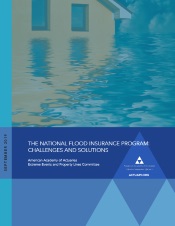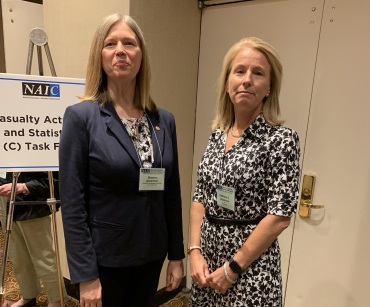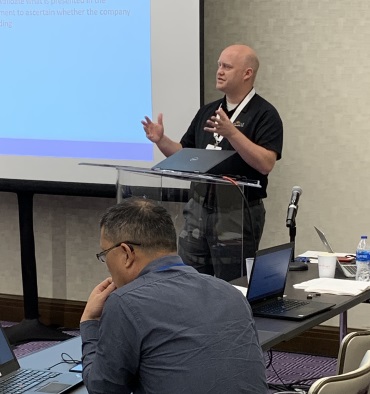Casualty Quarterly, Fall 2019
 |
|
Fall 2019
VOL 3 | NO 3 |
Q&A—Rich Gibson, Academy Senior P/C Fellow

Gibson
Rich Gibson, the Academy’s senior property/casualty fellow, has been tackling multiple key P/C issues this year, giving presentations around the country on everything from automobile insurance to climate risk. Casualty Quarterly undertook a Q&A with Gibson for a look at some recent and ongoing key P/C issues.
Automobile insurance always seems to be an important P/C topic. In the past few months, you have spoken in rate hearings in the District of Columbia, at the National Council of Insurance Legislators, and at the NAIC’s Insurance Summit. Where are you going next?
It is hard to overstate the importance of the automobile and automobile insurance industries to the U.S. and world economies. Consequently, there is a high level of focus on the work that we actuaries do in helping to keep the auto insurance mechanism sound. I feel fortunate to have had a chance to be involved in those meetings, and have also appreciated the opportunity to work with volunteers on the Academy’s Automobile Insurance Committee. In November, I will be moderating a panel at the Academy’s Annual Meeting and Public Policy Forum on predictive models and external data. While not strictly focused on auto insurance, it will no doubt get some ongoing attention. [Editor’s note: See the full list of P/C topics in the Annual Meeting breakout sessions webpage.]
All of that said, the Academy has considerable breadth regarding P&C issues. Lately, I have had a chance to work with our Cyber Risk Task Force volunteers as they work to expand the knowledge base on this emerging topic. I have also had a chance to work with the cross-organizational team from the Casualty Actuarial Society, the Society of Actuaries, the Canadian Institute of Actuaries, and the Academy as they work on the Actuaries Climate Index (ACI) and the impending Actuaries Climate Risk Index (ACRI). I can’t say enough about the dedication that this team has had in the efforts to research and quantify how climate events are changing—and changing our lives.
Predictive modeling for automobile insurance rates seems to get a lot of attention. Do you see issues being raised in workers’ comp or other lines where it is being used?
Part of the reason predictive modeling has gotten so much attention in auto insurance is that the models are continuing to evolve rapidly, and they are doing so at a time when auto insurance rates have been moving up. This can create a perception that the models are driving overall rate increases. While the models clearly impact the premiums of individual insureds, the broader need for rate increases is being caused by cost increases in the insurance system. Other lines of coverage will no doubt have issues, but the care and skill that actuaries put into their models and the training and guidance that we get from the actuarial standards of practice will serve well as things evolve in those lines.
At the NAIC seminar on predictive modeling, there was a lot of discussion about quality control of data that comes from external sources. How big of an emerging issue is this?
The trend is clearly in the direction of more data and more granular data. I suspect that it means more data vendors as well. One has to be concerned with what standards are being used to assure the veracity of the data. Actuaries have always been concerned with data quality, and I can envision the profession having a strong impact on the issue of quality standards for external data.
It’s the tail end of hurricane season, and climate risk always seems to be a big topic this time of year. Is it a growing topic among insurance audiences? Related, you’ve spoken with various audiences about the Actuaries Climate Index, and the upcoming Actuaries Climate Risk Index. What do they want to know?
The answer to that is it depends on the audience. The ACI tracks changes in extreme weather over time and demonstrates how the weather in more recent periods is more extreme than in the selected reference period. While this is an important finding, I suspect interested parties are looking for how that translates into insured losses and claims dollars. The ACRI aims to address that. Considerable research efforts by members of the team across the four sponsoring organizations has gone into answering that question. As the process moves forward, I would expect more clarity around that question as well as improvements from more granular data that underlies the ACI.
The Academy just recently updated its 2017 flood insurance monograph (see story, below)—what’s the latest that’s been happening with the National Flood Insurance Program (NFIP), and what is your role in the Academy’s efforts regarding the NFIP?

Gibson in his office at Academy headquartersObviously, the Academy has a strong public policy focus. If I can be helpful to policymakers as they seek to understand the actuarial aspects of flood insurance, that would be very gratifying. The federal and state governments have considerable impact on hard-to-insure exposures in many lines of insurance. Flood is certainly one of those, and the NFIP has carried the load on flood insurance for several years. It has paid out over $66 billion of claims to flood victims from 1978 through 2018. The Academy will be interested in providing guidance regarding ongoing renewal legislation, and we will be interested in the rollout of “Risk Rating 2.0” by the NFIP.
What are some of the other big P/C issues you see on the national agenda?
P/C coverage is very important to a well-functioning economy, so it is difficult to boil it down to just a few lines. I will reiterate some that we have already talked about, as I don’t think you can emphasize them enough.
Extreme events—weather-related, wildfires—are frequently in the news. Flooding has been especially problematic this year throughout the Midwest and parts of the South. Predictive modeling and its impact on pricing accuracy and soundness will continue to be debated. I’d very much like to be wrong, but I think that the issue of cyber risk is going to continue to grow.
Turning to some that we have not mentioned, renewal of the Terrorism Risk Insurance Act (TRIA) is very important. TRIA’s statutory authority expires at the end of 2020, but commercial insurance contracts already are being written that extend past that point.
Insurance fraud adds considerable cost to the insurance system and impacts the price of policies for honest insurance consumers. And finally, availability and affordability of quality coverages for insurance consumers is an area where actuaries can have ongoing impact. Auto and homeowners’ insurance lines are politically sensitive, because they affect consumers everywhere at very basic levels.
Academy Comments to NAIC on Regulatory Guidance, ‘Qualified Actuary’ Definition
The Academy’s Committee on Property and Liability Financial Reporting (COPLFR) sent two comment letters in late September to the NAIC’s Casualty Actuarial and Statistical Task Force Actuarial Opinion Working Group (AOWG).
The first letter was on the Regulatory Guidance on Property and Casualty Statutory Statements of Actuarial Opinion, Actuarial Opinion Summaries, and Actuarial Reports for the Year 2019, which was issued on Aug. 30. The letter asked questions and offered comments on qualification documentation and regulatory guidance, and suggested adding an FAQ section.
The second letter, also to the AOWG, was on the Sept. 17 revision of the guidance document. The revisions were in response to COPLFR’s original comments around the level of detail and duplication in the last few pages of the Regulatory Guidance, as well as a suggestion to reduce the amount of prescriptive language, the letter states. COPLFR suggested the Regulatory Guidance be modified to more directly follow the requirements of the NAIC Opinion Instructions.
An earlier letter by Academy President Shawna Ackerman, sent in late July, on the exposed draft 2019-20BWG to the NAIC’s Blanks (E) Working Group, related to the instructions themselves and at that time, proposed requirements for actuaries who issue Property and Casualty statements of actuarial opinion (SAOs).
NAIC’s Casualty Actuarial and Statistical Task Force (CASTF) and a three-member Ad Hoc Executive Committee (EX) leadership group that has handed down certain decisions to CASTF have most recently been debating whether to reference Academy membership as a requirement for a qualified actuary to issue a Property and Casualty SAO, as is the long-standing, tested, and effective requirement in the Life and Health SAO definitions of how an actuary demonstrates being a “qualified actuary,” the letter states.
“We believe that Academy membership should similarly be a prerequisite for an actuary to issue property and casualty SAOs,” Ackerman wrote. “We have urged the NAIC to draw on the Academy’s experience and knowledge to ensure actuaries are held to the time-tested standards that are in place today.”
The letter also included specific comments prepared by the Academy’s Committee on Property and Liability Financial Reporting (COPLFR) that identifies additional elements of confusion and complexity in the exposure draft.
Webinar Planned on ‘Qualified Actuary’ Definition
COPLFR plans to host a webinar on 2019 changes in the requirements for appointed actuaries. The NAIC recently took final action on the new rules and is developing associated regulatory guidance. This webinar will seek to answer members’ questions on the new rules. This webinar will be in addition to COPLFR’s annual presentation of the actuarial opinion instructions in the practice note and during the Seminar on Effective P/C Loss Reserve Opinions, Dec. 4–5 in Baltimore. Look for announcements containing details of the webinar in forthcoming Academy publications.
Flood Insurance Monograph Updated
 The P/C Extreme Events and Property Lines Committee has updated a public policy monograph, The National Flood Insurance Program: Challenges and Solutions, originally published by the Flood Insurance Work Group in early 2017, to include more recent data on hurricane-related damage, the National Flood Insurance Program (NFIP), and more.
The P/C Extreme Events and Property Lines Committee has updated a public policy monograph, The National Flood Insurance Program: Challenges and Solutions, originally published by the Flood Insurance Work Group in early 2017, to include more recent data on hurricane-related damage, the National Flood Insurance Program (NFIP), and more.
The update includes damages assessed from the big storms of the 2017 Atlantic hurricane season—hurricanes Harvey, Irma, and Maria—and the 2018 season, and outlines recent legislative activity and the multiple stopgap extensions to the NFIP in the past few years.
The monograph provides objective information to policymakers on differing approaches to premium setting and program financing for the NFIP, including both public and private financing mechanisms.
Academy Presents at NAIC Summer Meeting

Ackerman (left) and Odomirok at NAIC
Academy volunteers presented at the NAIC Summer 2019 National Meeting in New York City in early August, addressing professionalism, property/casualty, and other practice-area topics. Academy President Shawna Ackerman, President-Elect nominee and Committee on Qualifications member Tom Campbell, Actuarial Standards Board Chairperson Kathy Riley, and Actuarial Board for Counseling and Discipline member Godfrey Perrott gave professionalism updates to NAIC’s Casualty Actuarial and Statistical Task Force (CASTF). Volunteers also presented to CASTF and attended other NAIC group meetings.
Casualty presentations included:
- Lauren Cavanaugh, Academy board member and chairperson of the Property and Casualty Risk-Based Capital Committee, reviewed the scope letter that her committee submitted to the Property and Casualty Risk-Based Capital (E) Working Group, outlining research they will be doing on underwriting risk.
- Kathy Odomirok, chairperson of the Committee on Property and Liability Financial Reporting, gave a presentation to the Statutory Accounting Principles (E) Working Group on the committee’s recent comment letter regarding inconsistencies in how loss portfolio transfer is handled in financial reports.
- Senior P/C Fellow Rich Gibson gave a presentation to CASTF on recent initiatives by several committees of the Casualty Practice Council, emphasizing the day-long seminar on predictive modeling that the Academy presented at the NAIC’s Insurance Summit in June. He also provided a progress report on the Actuaries Climate Risk Index.
Panel Presents on Climate Indexes at Statistical Meeting

MusulinThe Academy organized a panel that presented on “Assessing Climate Risks” at the American Statistical Association’s 2019 Joint Statistical Meetings in Denver in late July. Steve Jackson, the Academy’s assistant director for research, was joined by Academy members Steve Kolk, a member of the Extreme Events and Property Lines Committee, and past Academy Casualty Vice President Rade Musulin in discussing the current status and future prospects of the Academy co-sponsored Actuaries Climate Index and the Actuaries Climate Risk Index, as well as the Australian Actuaries Climate Index and other actuarial climate indexes.
Two non-actuarial environmental statisticians were also on the panel—Peter Sousounis, director of climate change modeling at AIR Worldwide, and Michael Wehner, senior staff scientist at the Lawrence Berkeley National Laboratory and a lead author of the Intergovernmental Panel on Climate Change (IPCC) Climate Assessments and the U.S. National Climate Assessments.
Latest ACI Data Released
 The Academy and the other sponsoring U.S. and Canadian organizations updated the Actuaries Climate Index (ACI) with data from the winter of 2018–19, with the 1.00 value for the season contributing to an upward trend in the average ACI value for winter.
The Academy and the other sponsoring U.S. and Canadian organizations updated the Actuaries Climate Index (ACI) with data from the winter of 2018–19, with the 1.00 value for the season contributing to an upward trend in the average ACI value for winter.
Taking the new data into account, the average of the last five winter ACI values was higher than the average for the five winters ending in 2017–18. The increase in average winter values is one factor driving the ACI’s five-year moving average to new highs. The moving average increased by 0.08, from 1.02 to 1.10, the largest quarter-to-quarter change over the period studied, January 1961 through February 2019.
“Since last quarter, the ACI moving average increased by the largest amount during the 59-year period covered by the index, making this five-year period the greatest outlier so far in terms of frequent extreme weather and sea level change,” said Doug Collins, chair of the Climate Index Working Group.
The ACI is jointly sponsored by the Academy, the Canadian Institute of Actuaries, the Casualty Actuarial Society, and the Society of Actuaries.
CLRS Features Academy Presentations

Freihaut presents at a sessionSeveral Academy representatives gave presentations at the Casualty Loss Reserve Seminar and Workshops (CLRS), held in mid-September in Austin, Texas, and jointly sponsored by the Academy and the Casualty Actuarial Society.
Academy volunteers were on the CLRS program faculty. Kathy Odomirok, chairperson of the Academy’s Committee on Property and Liability Financial Reporting (COPLFR), held a workshop on writing Statements of Actuarial Opinion, at which COPLFR Vice Chairperson Derek Freihaut was a presenter.
Other sessions included:
- Senior P/C Fellow Rich Gibson and Deborah Rosenberg, vice chairperson of the Actuarial Board for Counseling and Discipline, led a session on the Code of Professional Conduct.
- Ralph Blanchard, a longtime Academy volunteer, and COPLFR member George Levine presented at a session on reporting retroactive insurance, drawing heavily on the comment letter COPLFR sent to the NAIC earlier this year.
- COPLFR members John Gleba and Michelle Iarkowski led a presentation on data and documentation, previewing a portion of the Academy’s annual P/C loss reserve opinions seminar.
- Susan Forray, chairperson of the Medical Professional Liability (MPL) Committee, led a discussion of new developments in MPL insurance.
Academy Senior P/C Fellow Rich Gibson gave a presentation in mid-July to the National Council of Insurance Legislators’ (NCOIL) Property and Casualty Insurance Committee at NCOIL’s Summer Meeting in Newport Beach, Calif. The presentation focused on factors influencing automobile insurance rates.
The presentation covered regulatory issues, claim cost trends, and other considerations including distracted driving. After his presentation Gibson spoke with, among others, California Assemblyman Ken Cooley (pictured), about the subject.
|
Copyright © 2019 American Academy of Actuaries. All Rights Reserved. |



 Phone: 202-223-8196
Phone: 202-223-8196
